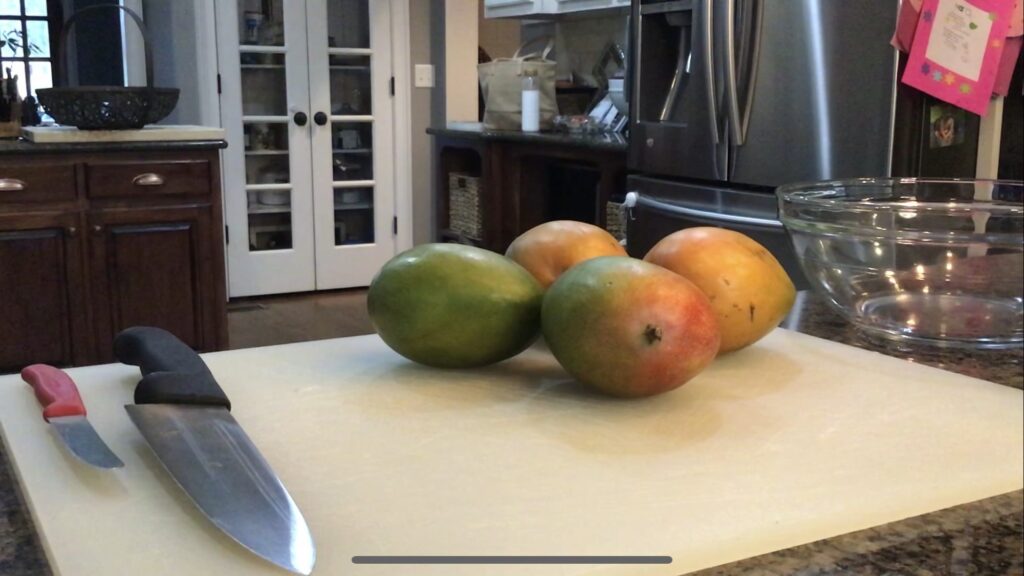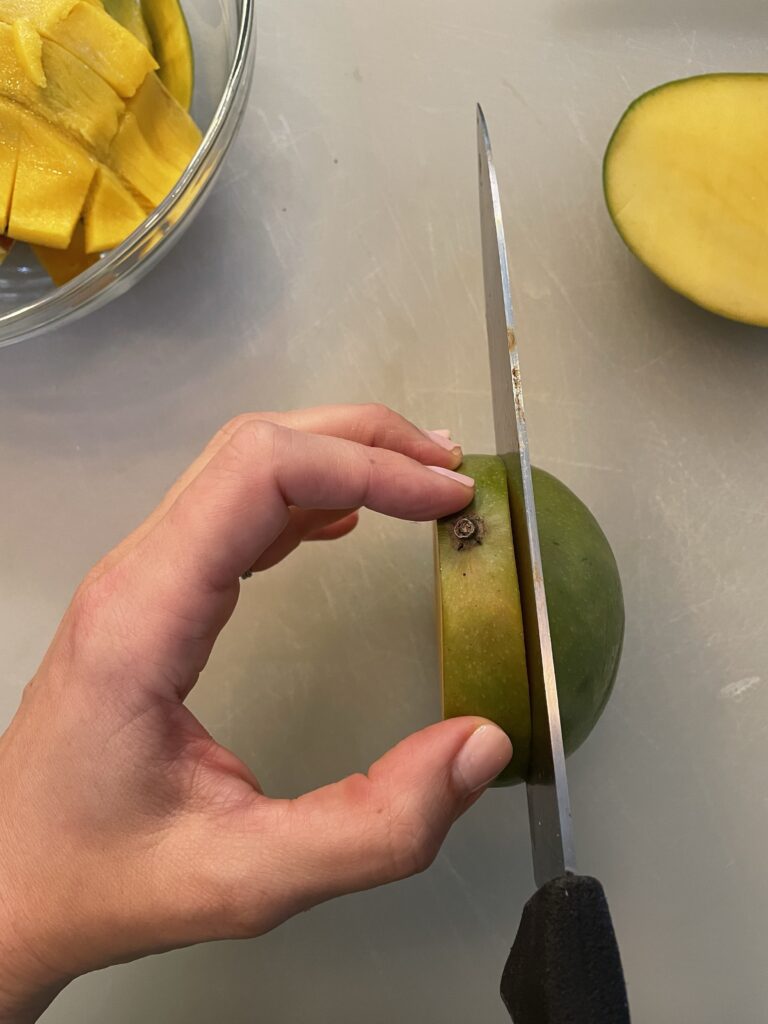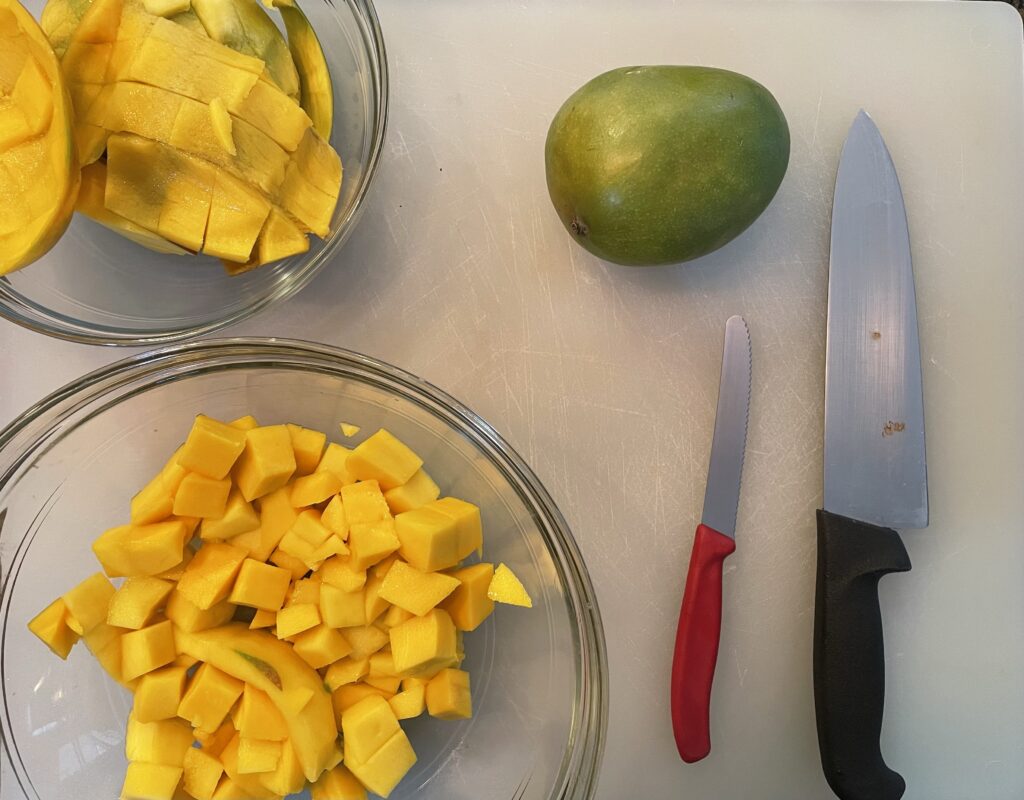How to Cut a Mango the Right Way – The First Time!

Mangoes come in all different shapes and colors including yellow, orange, red, and green – but one thing is for certain- they ALL have a large oblong central pit that can be quite an obstacle when trying to cut it.

- Nutritionally they’re an excellent source of Vitamin A and C.
- Good source of fiber and B6.
- They also deliver Vitamin E, Vitamin K, Thiamin, Riboflavin, Folate, Potassium and Copper (~6-9% DV).
- Also contain the antioxidant polyphenols and beta-carotene and one unique to mango known as mangaferin (axanthone).
How to choose a mango
Tip #1 – don’t go by the color! Instead, smell the fruit at the stem end, where it was picked from the tree. They should also give slightly when pressed firmly with your fingers. (Careful not to bruise the fruit!). If it has a faint tropical aroma, it’s ready! If yours seem firm, let them ripen in your fruit bowl next to the bananas.
Tip #2 – choose mangoes that are heavy for their size with firm skin, free from bruises.
Tip #3 – if the fruit has a sour or alcohol smell, pass. This means it has started to ferment.
Storing mangoes
If the fruit is unripe/ firm when purchased, ripen at room temperature until the flesh softens a bit. You don’t want it to be mushy though. Once it’s ripe, store in the refrigerator to help preserve freshness.
Tip : Store mango in a paper bag on the counter to speed up ripening process.



How to cut a mango in three easy steps
- Identify the large oblong pit in it’s center.
- With stem side up, cut down one side of the pit(slightly off center) from top to bottom, curving slightly with the shape of the pit. Do the same on the other side.
- Take each half of the mango and score the flesh in a grid like pattern (but not through the skin). Turn the mango out so the cube pop out. Cut them away with a paring knife.
Eat right away or store in the fridge for several days. Cut mango may be frozen for several months.

How to enjoy mango
- Eat it as a snack all on it’s own
- Bake it into a crisp with apricots
- Blend it into a smoothie with banana, cauliflower, almond milk and vanilla
- Dice it into a salsa with jalapenos, onion, tomatoes and cilantro
- Pair mango with apricot, avocado, chicken chiles, cilantro, cucumber, fish, jicama, lime or orange juice, pineapple, starfruit or tangerines.
Nutrition benefits
- Mangoes vitamin C content increases collagen formation.
- One UC Davis study found that women who ate ½ cup mango four times per week saw a 23% decrease in wrinkles after 2 months!
- Polyphenols in mangoes have anti-inflammatory benefits that are responsible for lower blood pressure and improved A1C measurements in participants who ate about 400g mango daily for 6 weeks. Another study found the same amount of mango had improved metabolism.
- Children who regularly included mango in their diet had higher intakes of immune supporting vitamins including A, C, B6, fiber and potassium.
- Both children and adults eating mangoes have higher intakes of fiber and potassium, than those who don’t eat mango.
- Mango consumption may improve glucose control and reduce inflammation when compared to other sweet snacks.
- One serving of mango contains 7% of your daily fiber intake.
- Mangoes contain over 20 different vitamins and minerals making them a nutrient dense choice!
Learn how to cut a mango so you can gain all of these nutrition benefits!

